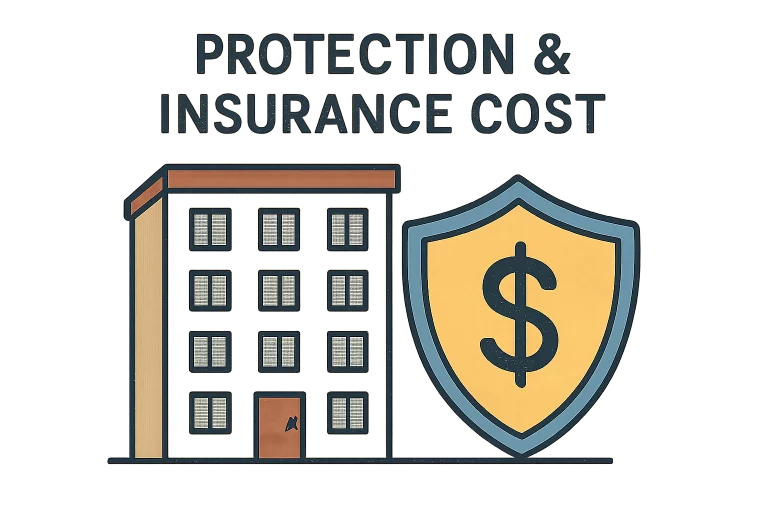Apartment building insurance represents a significant but essential expense for property owners and real estate investors. This specialized insurance coverage safeguards properties and landlords against a range of financial risks, including damages from fire, storms, water leaks, vandalism, and liability for tenant injuries. In today’s unpredictable climate—both financially and environmentally—the pressing question for owners isn’t whether to obtain coverage, but rather: how much will it actually cost, and are there ways to control those costs? Many owners worry about affordability as premiums have continued to escalate, yet understanding the full scope of apartment building insurance rates can offer valuable clarity.
It’s not enough to simply accept a quoted premium at face value. Owners need a strategic approach to managing and budgeting for insurance. Knowing which factors drive costs, how rates break down on both a per-building and per-unit basis, and the actionable steps to rein in expenses empowers owners to make sound business decisions. Staying proactive is the key to not only protecting your investment but also ensuring that long-term operational expenses remain manageable and predictable within your property portfolio.
Average Insurance Costs for Apartment Buildings
The cost of insurance for apartment buildings is influenced by a multitude of factors, resulting in a significant range of premiums. On average, monthly premiums can be as low as $100 for smaller or newer buildings in low-risk areas, but they can soar to as much as $1,200 per month for older, larger properties or those located in higher-risk regions. The range in cost reflects the varying risk profiles tied to building type, location, age, and the desired level of coverage. As highlighted in InsuranceNewsNet, rising construction costs, inflation, and increased natural disaster risks have also contributed to the recent spike in apartment building insurance premiums, further complicating the pricing landscape.
Translating those monthly premiums into annual expenses, the figures often fall between $3,000 and $6,000 a year for a typical 10-unit apartment building, while a 20-unit structure may cost between $6,000 and $12,000 annually. On a per-unit basis, the average annual insurance cost typically ranges from $300 to $600. These broad numbers underscore the significant impact that detailed property information and current market conditions can have on costs. Differences in deductible amounts, specific peril coverage, and policy add-ons, such as equipment breakdown or loss of rental income, also drive variations.

Factors Influencing Insurance Premiums
Understanding what goes into your premium calculations is critical for owners aiming to anticipate or reduce insurance expenses. Key factors that determine the final insurance rate include:
1. Location
The geographic position of an apartment building plays a pivotal role in determining insurance costs. Buildings located in regions prone to natural disasters—think hurricanes in Florida and Texas, earthquakes in California, or wildfires in the western U.S.—will see significantly higher premiums. For instance, in hurricane-vulnerable states such as Florida and Texas, the frequency and intensity of severe weather events have led insurers to dramatically raise rates, with reported insurance cost increases by 37% and 43% per unit between 2020 and 2022. These drastic jumps are a direct response to climate impacts as well as the increasing costs and frequency of claims. Even buildings in urban centers may incur higher premiums due to their proximity to risks such as crime or civil unrest.
2. Building Characteristics
The physical makeup and overall condition of the building are also crucial. Newly constructed apartment complexes built using modern, fire-resistant materials (such as concrete and steel) and equipped with up-to-date fire protection and security systems generally benefit from lower insurance rates. Properties with newer roofs, updated plumbing, secure electrical systems, and well-documented maintenance routines are considered safer and less prone to significant claims. On the other hand, older buildings—especially those constructed with outdated wiring, aging wooden structures, or inadequate fire precautions—are considered higher risk and will be charged higher premiums. Even cosmetic upgrades, such as installing new sprinklers, smart fire alarms, or advanced entry systems, can directly translate into improved insurability and reduced costs.
3. Claims History
Insurance underwriters meticulously assess a property’s claims history when calculating premiums. A building with a record of frequent or high-value insurance claims will be flagged as a greater risk, and as a result, premiums will increase. Property owners with multiple past claims—such as those for water damage, theft, or liability—may face surcharges or even potential non-renewal. In contrast, maintaining a strong, claim-free record offers a host of benefits: not only lower premiums but also greater leverage in negotiating renewal terms with insurance carriers. Proactive property management, timely repairs, and regular property inspections can all help prevent incidents that lead to claims and maintain favorable insurance histories.
4. Tenant Demographics
The profile of tenants occupying the building also has a direct effect on insurance pricing. Buildings that primarily serve transient populations, such as college students, short-term vacation renters, or seasonal workers, are generally seen as higher risk due to increased chances of damage or liability issues. Shorter-tenancy cycles tend to create more wear and tear and sometimes lead to gaps in responsible management. In contrast, apartments with long-term tenants—such as families or professionals—are often rewarded with lower insurance costs due to their more stable risk profile. Cultivating a dependable tenant base and screening for reliable renters can ultimately support better insurance rates in the long run.
Strategies to Mitigate Rising Insurance Costs
As insurance costs rise, owners may feel helpless in the face of market dynamics, but a number of actionable steps can materially impact their annual expenses:
- Implement Safety Measures: Upgrading your property with sprinkler systems, advanced fire and burglar alarms, and robust security lighting not only reduces risk but also communicates to insurers that you’re actively invested in risk management. Such measures often lead to premium discounts and more attractive policy terms.
- Regular Maintenance: Preventative upkeep on building systems—such as regular roof inspections, plumbing checks, and electrical system reviews—helps avoid costly claims stemming from deferred maintenance. Well-maintained properties are insurable at better rates and are less likely to encounter unplanned losses.
- Increase Deductibles: Willingly accepting a higher deductible reduces the insurer’s liability and usually results in lower monthly premiums. While this approach saves on premium costs, property owners should ensure they have access to sufficient funds to cover higher out-of-pocket expenses in the event of a claim.
- Work with Insurance Brokers: Partnering with a knowledgeable insurance broker or agent pays dividends. Skilled brokers understand trends, leverage relationships with multiple carriers, and use their expertise to negotiate not only the best coverage but also the most competitive rates for your unique property needs.
Conclusion
In summary, apartment building insurance is a complex but non-negotiable part of property management. Costs are shaped by many factors, including geographic location, structural and demographic considerations, claims history, and the constantly shifting insurance market. By staying informed about current apartment building insurance rates, proactively investing in the upkeep and safety features of their properties, and implementing measured risk management strategies, owners can better control this crucial operating expense and secure the long-term value of their investment. Navigating the insurance landscape with an informed, strategic approach will position property owners to thrive despite the challenges of rising premiums and market uncertainties.







